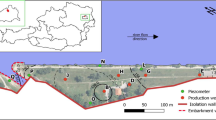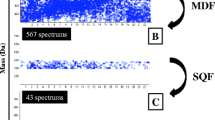Abstract
Emerging organic contaminants in wastewater are usually analyzed by targeted approaches, and especially estrogens have been the focus of environmental research due to their high hormonal activity. The selection of specific target compounds means, however, that most of the sample components, including transformation products and potential new contaminants, are neglected. In this study, the fate of steroidal compounds in wastewater treatment processes was evaluated by a nontargeted approach based on comprehensive two-dimensional gas chromatography–time-of-flight mass spectrometry. The potential of the nontargeted approach to generate comprehensive information about sample constituents was demonstrated with use of statistical tools. Transformation pathways of the tentatively identified compounds with steroidal four-ring structure were proposed. The purification efficiency of the wastewater treatment plants was studied, and the distribution of the compounds of interest in the suspended solids, effluent water, and sludge was measured. The results showed that, owing to strong adsorption of hydrophobic compounds onto the solid matter, the steroids were mostly bound to the suspended solids of the effluent water and the sewage sludge at the end of the treatment process. The most abundant steroid class was androstanes in the aqueous phase and cholestanes in the solid phase. 17β-estradiol was the most abundant estrogen in the aqueous phase, but it was only detected in the influent samples indicating efficient removal during the treatment process. In the sludge samples, however, high concentrations of an oxidation product of 17β-estradiol, estrone, were measured.



Similar content being viewed by others
References
Castillo S, Mattila I, Miettinen J, Oresic M, Hyötyläinen T (2011) Data analysis tool for comprehensive two-dimensional gas chromatography/time-of-flight mass spectrometry. Anal Chem 83:3058–3067. doi:10.1021/Ac103308x
Directive 2013/39/EU of the European Parliament and of the Council of 12 August 2013 amending Directives 2000/60/EC and 2008/105/EC as regards priority substances in the field of water policy
Evgenidou E, Konstantinou I, Lambropoulou D (2015) Occurrence and removal of transformation products of PPCPs and illicit drugs in wastewaters: A review. Sci Total Environ 505:905–926. doi:10.1016/j.scitotenv.2014.10.021
Haddad T, Baginska E, Kummerer K (2015) Transformation products of antibiotic and cytostatic drugs in the aquatic cycle that result from effluent treatment and abiotic/biotic reactions in the environment: an increasing challenge calling for higher emphasis on measures at the beginning of the pipe. Water Res 72:75–126. doi:10.1016/j.watres.2014.12.042
Hamid H, Eskicioglu C (2012) Fate of estrogenic hormones in wastewater and sludge treatment: a review of properties and analytical detection techniques in sludge matrix. Water Res 46:5813–5833. doi:10.1016/j.watres.2012.08.002
Hernández F, Ibáñez M, Bade R, Bijlsma L, Sancho JV (2014) Investigation of pharmaceuticals and illicit drugs in waters by liquid chromatography-high-resolution mass spectrometry. TrAC 63:140–157. doi:10.1016/j.trac.2014.08.003
Hummel J, Strehmel N, Selbig J, Walther D, Kopka J (2010) Decision tree supported substructure prediction of metabolites from GC-MS profiles. Metabolomics 6:322–333. doi:10.1007/s11306-010-0198-7
Jernberg J, Pellinen J, Rantalainen AL (2013a) Identification of organic xenobiotics in urban aquatic environments using time-of-flight mass spectrometry. Sci Total Environ 450:1–6. doi:10.1016/j.scitotenv.2013.02.006
Jernberg J, Pellinen J, Rantalainen AL (2013b) Qualitative nontarget analysis of landfill leachate using gas chromatography time-of-flight mass spectrometry. Talanta 103:384–391. doi:10.1016/j.talanta.2012.10.084
Kopperi M, Ruiz-Jimenez J, Hukkinen JI, Riekkola M-L (2013) New way to quantify multiple steroidal compounds in wastewater by comprehensive two-dimensional gas chromatography–time-of-flight mass spectrometry. Anal Chim Acta 761:217–226. doi:10.1016/j.aca.2012.11.059
Law V, Knox C, Djoumbou Y, Jewison T, Guo AC, Liu YF, Maciejewski A, Arndt D, Wilson M, Neveu V, Tang A, Gabriel G, Ly C, Adamjee S, Dame ZT, Han BS, Zhou Y, Wishart DS (2014) DrugBank 4.0: shedding new light on drug metabolism. Nucleic Acids Res 42:D1091–D1097. doi:10.1093/Nar/Gkt1068
Lishman L, Smyth SA, Sarafin K, Kleywegt S, Toito J, Peart T, Lee B, Servos M, Beland M, Seto P (2006) Occurrence and reductions of pharmaceuticals and personal care products and estrogens by municipal wastewater treatment plants in Ontario, Canada. Sci Total Environ 367:544–558. doi:10.1016/j.scitotenv.2006.03.021
Loos R, Carvalho R, Antonio DC, Cornero S, Locoro G, Tavazzi S, Paracchini B, Ghiani M, Lettieri T, Blaha L, Jarosova B, Voorspoels S, Servaes K, Haglund P, Fick J, Lindberg RH, Schwesig D, Gawlik BM (2013) EU-wide monitoring survey on emerging polar organic contaminants in wastewater treatment plant effluents. Water Res 47:6475–6487. doi:10.1016/j.watres.2013.08.024
Martin J, Camacho-Munoz MD, Santos JL, Aparicio I, Alonso E (2012) Distribution and temporal evolution of pharmaceutically active compounds alongside sewage sludge treatment. Risk assessment of sludge application onto soils. J Environ Manage 102:18–25. doi:10.1016/j.jenvman.2012.02.020
Nurmi J, Pellinen J, Rantalainen AL (2012) Critical evaluation of screening techniques for emerging environmental contaminants based on accurate mass measurements with time-of-flight mass spectrometry. J Mass Spectrom 47:303–312. doi:10.1002/Jms.2964
Peng FQ, Ying GG, Yang B, Liu S, Lai HJ, Liu YS, Chen ZF, Zhou GJ (2014) Biotransformation of progesterone and norgestrel by two freshwater microalgae (Scenedesmus obliquus and Chlorella pyrenoidosa): Transformation kinetics and products identification. Chemosphere 95:581–588. doi:10.1016/j.chemosphere.2013.10.013
Prebihalo S, Brockman A, Cochran J, Dorman FL (2015) Determination of emerging contaminants in wastewater utilizing comprehensive two-dimensional gas-chromatography coupled with time-of-flight mass spectrometry. J Chromatogr A 1419:109–115. doi:10.1016/j.chroma.2015.09.080
Racz L, Goel RK (2010) Fate and removal of estrogens in municipal wastewater. J Environ Monit 12:58–70. doi:10.1039/B917298j
Richardson SD, Ternes TA (2011) Water analysis: emerging contaminants and current issues. Anal Chem 83:4614–4648. doi:10.1021/Ac200915r
Silva CP, Otero M, Esteves V (2012) Processes for the elimination of estrogenic steroid hormones from water: a review. Environ Pollut 165:38–58. doi:10.1016/j.envpol.2012.02.002
Slobodnik J, Mrafkova L, Carere M, Ferrara F, Pennelli B, Schuurmann G, von der Ohe PC (2012) Identification of river basin specific pollutants and derivation of environmental quality standards: a case study in the Slovak Republic. TrAC 41:133–145. doi:10.1016/j.trac.2012.08.008
Vieno N (2014) Hazardous substances at wastewater treatment. Project report. Finnish Water Utilities Association series number 34.
Acknowledgments
Financial support was provided by the Maj and Tor Nessling Foundation (Grant Number 2013194) and Tiina and Antti Herlin Foundation (Grant Number 20141172). Dr. Kathleen Ahonen is acknowledged for the improvement of the written language. Personnel of the WWTPs are thanked for their co-operation during sampling. The authors declare that they have no conflict of interest.
Author information
Authors and Affiliations
Corresponding author
Additional information
Responsible editor: Philippe Garrigues
Electronic supplementary material
Below is the link to the electronic supplementary material.
ESM 1
Schematic of the analytical methodology and data processing workflow. (PDF 317 kb)
Rights and permissions
About this article
Cite this article
Kopperi, M., Parshintsev, J., Ruiz-Jiménez, J. et al. Nontargeted evaluation of the fate of steroids during wastewater treatment by comprehensive two-dimensional gas chromatography–time-of-flight mass spectrometry. Environ Sci Pollut Res 23, 17008–17017 (2016). https://doi.org/10.1007/s11356-016-6800-4
Received:
Accepted:
Published:
Issue Date:
DOI: https://doi.org/10.1007/s11356-016-6800-4




